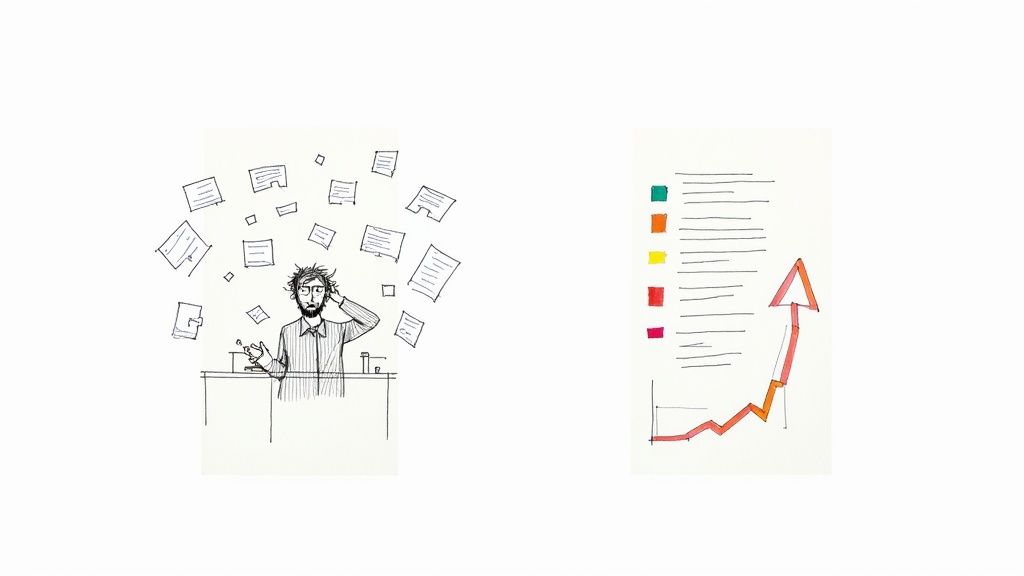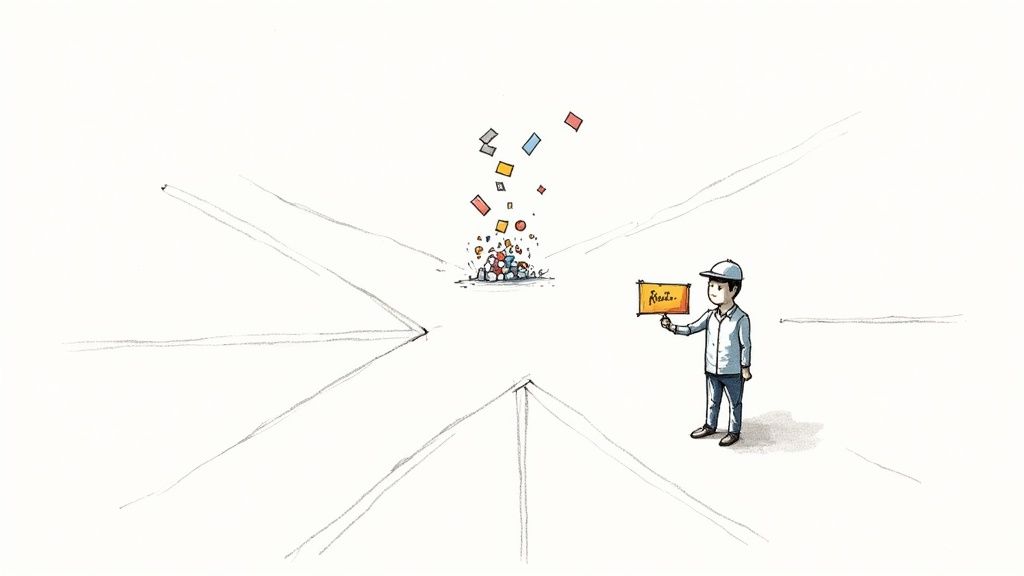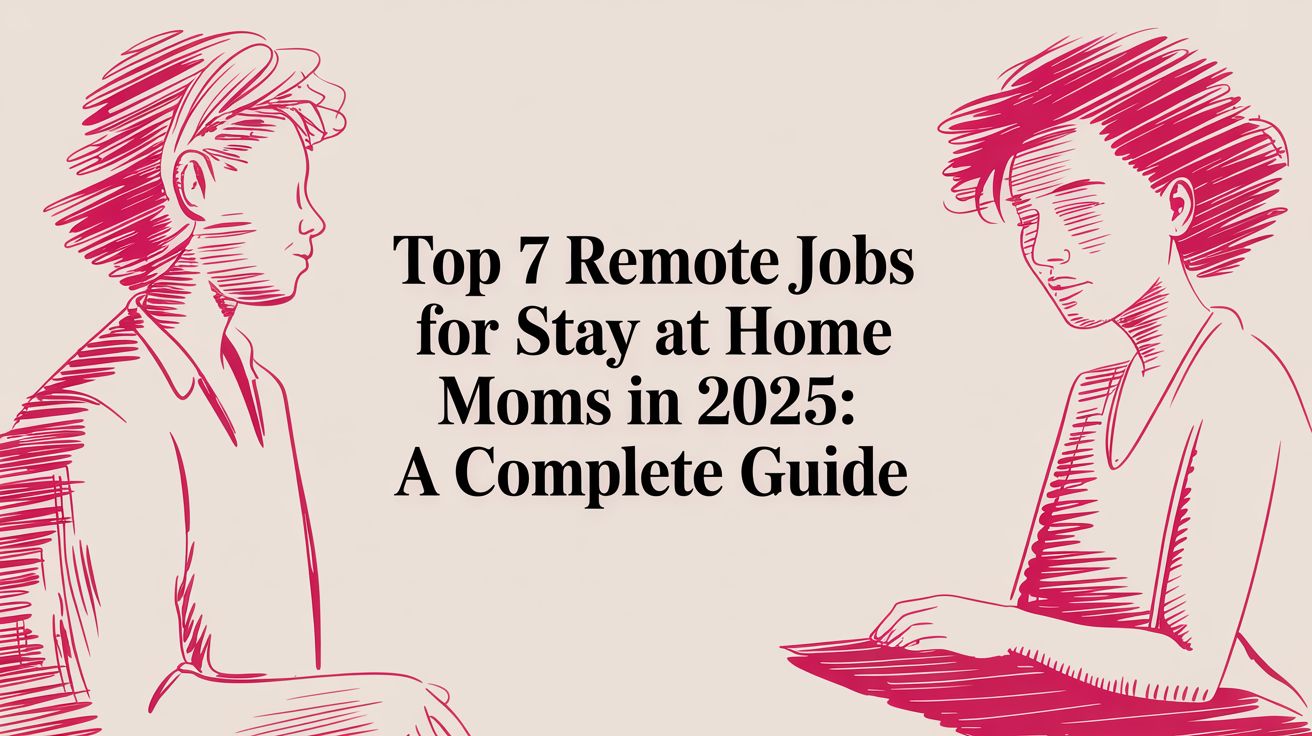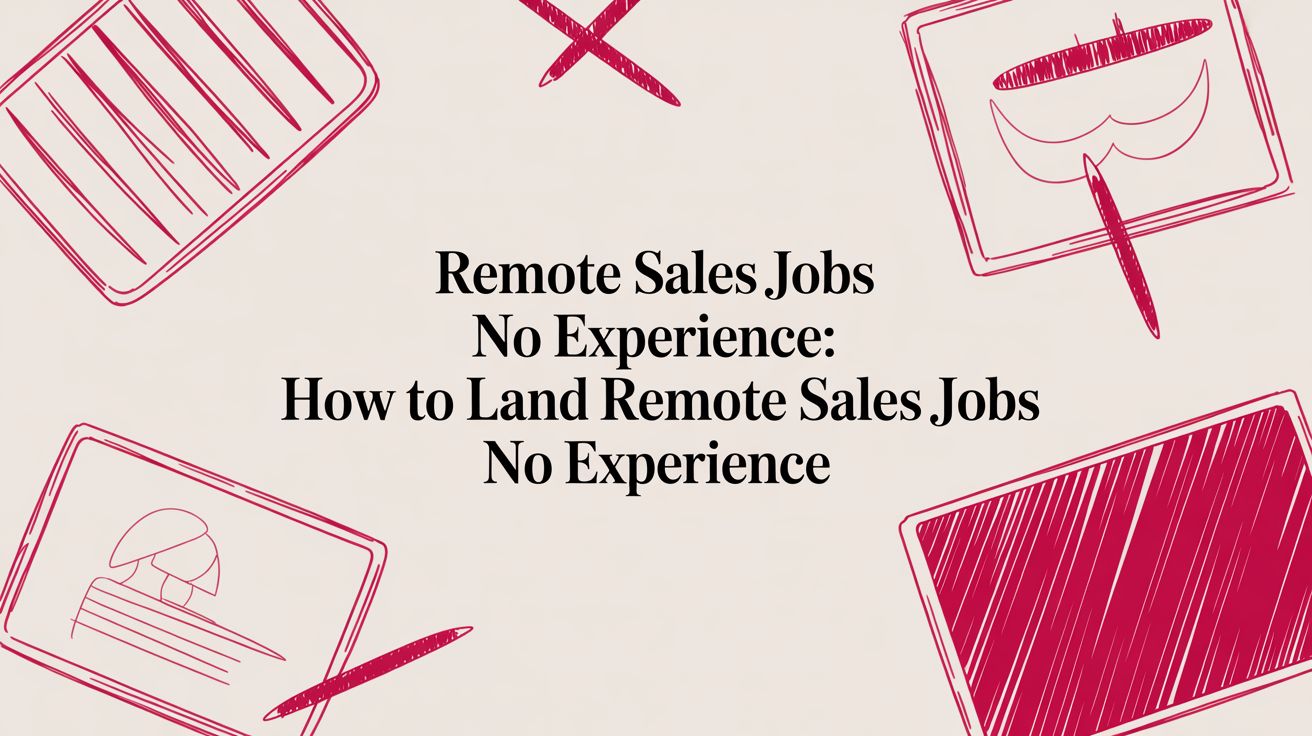How to Prioritize Tasks at Work for Better Results
Max
To really get a handle on your workload, you have to start by seeing the difference between urgent and important. It’s a classic trap: a flood of tasks that scream for your attention right now but do very little to move the needle on your big-picture goals. This constant firefighting is what leads straight to burnout. The only way out is to stop reacting and start managing your to-do list with a proven framework.
Why Prioritizing Your Work Is Non-Negotiable
We’ve all been there—that feeling of drowning in an endless sea of tasks. The answer isn’t to work longer; it’s to work smarter. Honestly, learning how to prioritize is probably the single most valuable skill you can develop in your career. It’s what flips your workday from a chaotic, reactive mess into a calm, proactive operation.

Without a system, you’ll burn through your best, most productive hours on trivial stuff. This doesn’t just stall your big, meaningful projects; it’s a major source of stress and feeling unhappy at work. The cost of just winging it is steeper than most people realize, hitting both your own well-being and the company’s bottom line.
The Real Cost of a Disorganized Workday
When every single task feels like a five-alarm fire, the fallout is inevitable. You start missing deadlines, the quality of your work slips, and you’re stuck in a constant state of feeling overwhelmed. This isn’t just a bad feeling—it has real, measurable consequences.
Think about it: Companies that actually train their teams on these techniques see a 13% improvement in overall team output. People who use a structured method are 30% more likely to get their most important work done on time. This is huge, especially when you consider that low engagement—often a direct result of poor task management—costs the global economy an estimated $438 billion a year in lost productivity. If you’re curious, you can dive deeper into more employee productivity statistics to see the full scope of the problem.
Prioritization isn’t about getting more things done; it’s about getting the right things done. It shifts your focus from being busy to being effective.
At the end of the day, learning to prioritize is about taking back control. It’s about making sure your best energy goes toward the work that truly aligns with your most ambitious goals—the kind of work that pushes both your career and your company forward.
Using the Eisenhower Matrix for Real-World Clarity
If you’re constantly fighting fires and feel like your to-do list is a tangled mess, the Eisenhower Matrix might be the best tool you’ve never used. It’s a dead-simple framework that forces you to separate what’s genuinely important for your long-term success from what’s just urgent noise demanding your attention.
It’s about shifting from being reactive to proactive, which is a game-changer when you’re working remotely.

The entire system is built on two simple axes: importance and urgency. Every task on your plate can be sorted into one of four quadrants, giving you a visual, actionable plan.
This isn’t just theory—it has a real impact. Remote-only employees who use prioritization techniques like this are 29 minutes more productive per day compared to their in-office peers. That’s huge, especially when studies show interruptions can happen as often as every three minutes. Without a system, it’s nearly impossible to stay on track. Discover more insights on productivity in the modern workplace.
Sorting Your Tasks Into the Four Quadrants
Let’s get practical and break down where your tasks actually go. This sorting process is where the magic happens.
Do First (Urgent & Important): These are the fires you absolutely have to put out. Think of a critical client bug that needs fixing now or a major project deadline that’s staring you down tomorrow. These are your non-negotiables—tackle them immediately.
Schedule (Important, Not Urgent): This is where your most valuable, career-defining work lives. It includes things like planning a long-term strategy, learning a new skill, or building key relationships. You have to carve out and protect time for these, or they’ll get buried by daily emergencies. Honestly, mastering this quadrant is the secret sauce, and you can find more tips in our guide on how to improve your time management skills.
Delegate (Urgent, Not Important): This quadrant is a trap. These tasks feel urgent but don’t actually move your own goals forward. We’re talking about responding to non-essential emails or sitting in on meetings where you’re not a key contributor. If you can, delegate them. Get them off your plate.
Delete (Not Urgent, Not Important): This is the easiest one. These tasks are just time-wasters. Mindlessly scrolling through social media, organizing a folder that nobody uses—anything that provides zero value. The action is simple: just eliminate them.
To make this even clearer, here’s a quick breakdown of the matrix in a table format.
The Eisenhower Matrix Quadrants Explained
| Quadrant | Description | Action to Take | Example |
|---|---|---|---|
| Quadrant 1 | Urgent & Important | Do | A client’s website just crashed. |
| Quadrant 2 | Not Urgent & Important | Schedule | Planning your team’s goals for the next quarter. |
| Quadrant 3 | Urgent & Not Important | Delegate | Responding to a routine inquiry from another department. |
| Quadrant 4 | Not Urgent & Not Important | Delete | Scrolling through social media feeds during work hours. |
By sorting your tasks this way, you get instant clarity. You’ll know exactly what to work on next, what can wait, and what you can—and should—ignore completely.
The real power of the Eisenhower Matrix is in Quadrant 2. Consistently making time for these important, non-urgent tasks is what drives significant career growth and prevents burnout.
This simple exercise is the first real step toward taking back control of your day and making sure your effort is actually invested in work that matters.
Simpler Frameworks for Daily Task Management
While the Eisenhower Matrix is a beast for big-picture planning, let’s be real—not every day calls for a four-quadrant deep dive. Sometimes you just need to sort through your to-do list and get moving, without all the heavy lifting.
When you need to figure out how to prioritize tasks at work right now, these simpler frameworks are your best friend. They cut through the noise, give you instant clarity, and help you make quick calls on what actually needs your attention.
The ABCDE Method for Clear Ranking
The ABCDE method is about as straightforward as it gets, which is why it works so well. It’s perfect for when your list is a mile long and everything feels urgent, from client work to that nagging administrative chore. You just run down your list and give each item a letter.
Here’s the breakdown:
- A Tasks: Your absolute non-negotiables. These are the things that carry serious consequences if they don’t get done today—think finishing a critical report for a major client.
- B Tasks: These are your “should-dos.” They’re still important, but the world won’t end if they slip to tomorrow. Following up on a non-urgent email or prepping for next week’s meeting fits perfectly here.
- C Tasks: The “nice-to-dos.” These tasks have zero negative consequences if postponed. Think organizing your digital files or catching up on industry news.
- D Tasks: Anything you can delegate. If someone else can handle it, pass it on. This frees you up for your ‘A’ and ‘B’ items.
- E Tasks: Tasks to eliminate. These are the time-wasters that don’t actually move you closer to your goals. Be ruthless and just cut them.
The golden rule is simple: never touch a ‘B’ task if you still have an ‘A’ task on your plate. This system naturally forces you to tackle your most impactful work first.
The MoSCoW Method for Project Clarity
Born out of the fast-paced world of software development, the MoSCoW method is a fantastic tool for both solo planning and team projects. It helps you categorize tasks or project requirements by their importance to a specific goal, which is a lifesaver for remote teams where clear alignment is everything.
This framework forces a conversation about what is truly essential versus what’s a “nice-to-have,” preventing scope creep and keeping everyone focused on the core objectives.
Let’s unpack it:
- Must-Have: These are the non-negotiables for the project to be a success. If you’re launching a website, a functioning checkout page is a must-have.
- Should-Have: Important, but not mission-critical for the initial launch. Think of adding a “related products” feature—it’s valuable, but the site can go live without it.
- Could-Have: These are desirable tweaks that have a pretty small impact on the outcome. Adding a new color theme to the site would be a good example.
- Won’t-Have: These are features or tasks that you all agree are out of scope for now. Defining these helps the team avoid distractions and stay focused.
Getting a handle on these prioritization techniques is a game-changer for remote work success. For more strategies to sharpen your skills, check out our guide on productivity tips for working from home. You can also discover effective time management tools that pair perfectly with these frameworks to boost your output.
Turn Your Priority List Into a Concrete Action Plan
A perfectly prioritized list is a fantastic start, but let’s be honest—it’s only half the battle. A list on its own is passive. To actually get things done, you need to turn those priorities into an active game plan. This is the moment you translate abstract goals into tangible actions you can schedule and complete.

For this, my go-to method is time blocking. Instead of staring at an endless to-do list, you assign every single task a specific slot on your calendar. This simple shift is a reality check, forcing you to be honest about what you can actually get done in a day.
When you know exactly what you’re supposed to be working on and when, you kill the decision fatigue that drains your mental battery. No more asking yourself, “Okay, what’s next?” You just glance at your calendar and get to work on the plan you already made.
From List to Schedule: A Practical Approach
The real secret to making time blocking work is realistic estimation. Most of us are terrible at guessing how long tasks will take, which blows up our entire schedule before the day even starts. A solid rule of thumb is to tack on a 20-25% buffer to your initial time estimate for any task.
So, if you think drafting that client proposal will take two hours, block out two and a half. This extra time is your safety net, accounting for unexpected interruptions, a quick coffee run, or the task just being trickier than you first thought.
A packed calendar isn’t a productive calendar. Effective time blocking includes white space for deep work, administrative tasks, and the inevitable curveballs your day will throw at you.
Here’s a glimpse of how a project manager might lay out their day with this method:
- 9:00 AM - 9:30 AM: Scan project boards and tackle urgent team messages.
- 9:30 AM - 11:30 AM: Deep work block: Update the project roadmap. No distractions.
- 11:30 AM - 12:00 PM: Buffer slot for email catch-up or any spillover tasks.
- 1:00 PM - 2:00 PM: Client status update call.
- 2:00 PM - 4:00 PM: Work block for drafting tickets for the next sprint.
This structure doesn’t just carve out time for high-priority work; it actively shields those blocks from getting derailed by minor requests. Getting your timing right is everything. Using one of the best time tracking apps for freelancers can give you the hard data you need on how long tasks actually take, helping you sharpen your estimates over time.
Navigating Common Prioritization Roadblocks
Even the most perfectly crafted prioritization system is going to run into a wall eventually: the real world. A sudden, “urgent” request from your manager can blow your entire day’s plan out of the water. This is a classic challenge when you’re figuring out how to prioritize, especially when working remotely where requests fly in from all directions, at all hours.

The trick isn’t to rigidly push back but to learn how to negotiate your workload. When a new high-priority task lands on your desk, don’t just silently absorb the extra work and stress. Give your manager context.
A professional way to handle this sounds like: “I can definitely take that on. Just so you know, I’m currently focused on Project X to meet Friday’s deadline. Which of these should I make the priority?” This simple question clarifies the trade-offs and helps your manager make a smart, informed decision.
Suddenly, the conversation shifts from your capacity to a strategic choice about what truly matters most for the team.
Conquering Mental Hurdles
Sometimes the biggest roadblock isn’t your manager—it’s you. We all have a tendency to gravitate toward the easy, low-impact tasks because they give us that quick hit of accomplishment. It’s a sneaky little habit called “productive procrastination.” While it feels good to clear out the small stuff, it can completely derail your progress on the projects that actually move the needle.
Another common trap is the fear of saying “no.” Protecting your time and focus is absolutely essential. Setting firm boundaries isn’t about being difficult or unhelpful; it’s about having the bandwidth to deliver high-quality work on your most critical assignments.
For some practical advice on this, our guide on how to set boundaries at work has scripts and strategies to help you communicate your capacity without sounding difficult. Protecting your focus is a non-negotiable part of any successful prioritization strategy.
Your Prioritization Questions Answered
Even with the best frameworks in your back pocket, you’re bound to run into some real-world snags. Making prioritization a habit that sticks means knowing how to handle these common questions when they pop up.
Let’s dig into a few things that often trip people up as they learn how to prioritize tasks at work effectively.
How Often Should I Re-Evaluate My Priorities?
The short answer? Daily. Things move fast in a remote environment. A quick 10-minute review each morning is non-negotiable for me. It’s the perfect time to adjust for new requests and see if any deadlines have shifted overnight.
I also recommend a bigger-picture weekly check-in. This is when you zoom out and make sure the small things you’re doing every day still line up with your larger, long-term goals.
What Is the Best Tool for This?
Honestly, the best tool is the one you’ll actually use. It doesn’t matter if it’s a simple app like Todoist, a powerful project management platform like Asana, or just a classic pen and paper.
These prioritization frameworks are tool-agnostic. The system is what matters, not the software.
The goal isn’t just to make a list; it’s to create a plan. Communicating that plan, especially to stakeholders, is just as important as creating it.
What happens when your manager drops a “low-priority” task on your plate and expects it done now? Being transparent is your best bet. We actually cover how to navigate those exact conversations in our guide on how to manage client expectations.
Ready to find a role that values smart work over long hours? At Remote First Jobs, we connect you with verified, remote-first companies that prioritize a healthy work-life balance. Find your next opportunity today at https://remotefirstjobs.com.


